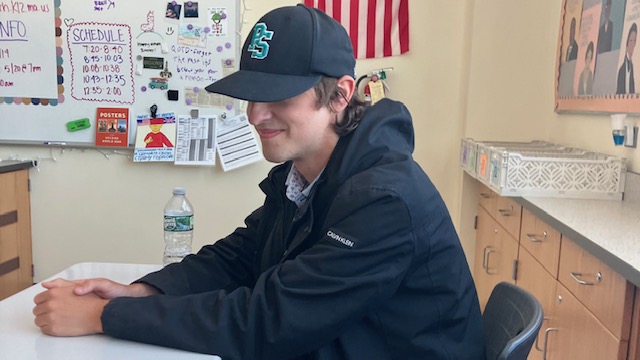You hear it every day, from Mr. North shouting on the third floor to Mr. Costa yelling down in the gym, “Take off your hats and hoods. Take off those hats!” But why? What makes wearing hats such a cardinal sin in the eyes of the school? The policy frustrates students and some teachers but is unlikely to be changing. But is it illegal?
According to the school handbook hats are not allowed because, “Hats, bandanas, sweatshirt hoods, and other headgear are not considered appropriate attire inside a school building, and, as such, are not to be worn.”
Appropriate attire is an interesting choice of words, however Mrs. Fry said that this is only part of the reason hats are not allowed. “It comes down to school safety, and that’s the main reason they aren’t allowed,” she said. “We’ve seen on the cameras before, if three students are wearing the same hat, telling them apart becomes incredibly difficult,” she said.
However most students disagree. Senior Charlie Ruggiero said, “Wearing hats in school has been restricted for far too long. It is just another opportunity for a student to show their personality and represent themselves. How much is a hat really being used to conceal identity? Most people want to just wear hats for comfort and I don’t know why the school… makes it out to be more than that.”
Many students argue the school is taking their freedom of expression and personality away from them by censoring how they dress.
School law and legal expert Jeffery Pyle, whose case as a student in 1995 defined exactly what schools could and could not regulate when it comes to student dress, said he believes that the school can indeed regulate hats.
“The dress code sounds like it is constitutional to me. Schools cannot regulate what you say with conduct, however it can regulate things like hats and the length of skirts. For example you have to wear a shirt to school, and the school can regulate this, “ Pyle said.
“The school doesn’t have to justify the decision with things like public safety, unless it infringes on protected rights. The ability to wear a Red Sox tee-shirt is not equal to a Red Sox hat–they are different articles of clothing so they have different protections,” Pyle said.
However, the actual wording of the Massachusetts State statute regulating student dress code at public schools is so ambiguous it’s possible Plymouth South could be in violation. Massachusetts State Law, Section 83, Chapter 71 states: “School officials shall not abridge the rights of students as to personal dress and appearance except if such officials determine that such personal dress and appearance violate reasonable standards of health, safety and cleanliness.” The school’s only justification of banning hats would be that it’s unreasonably unsafe for students to wear hats, which seems unlikely since many high schools allow hats and don’t seem to have safety issues.
Plymouth South is not a gang school or one that has a large amount of disciplinary problems, so why are these restrictions there in the first place? While traditionally wearing a hat was labeled disrespectful years ago, that can no longer be a reason schools can ban hats because under state law students can wear shirts far worse–ones showing they dislike a cause or even an elected leader and it is protected under free speech in Massachusetts. So while a lot of questionable material can be worn, strangely it is the common hat and hood that seems to attract the most criticism by administration at South. Yet with all the frustration from students aimed at one simple issue related to the dress code, one wonders if the school system just makes it out to be a bigger issue than it is.
Some teachers also agree the “no hat” policy seems outdated.
“The only reason that I have heard for why hats and hoods are banned from classrooms is that there’s a respect issue. I don’t think that there is a teacher in this building who thinks that wearing hats is disrespectful. With all the work the school has done to better students’ social and emotional health, ignoring hats and hoods can be dangerous to a students social health. For example if a student got a bad haircut and we stopped him from wearing a hat, that negatively affects his view of the school and his social health,” said English Teacher Ms. Evans.
However, other teachers do support the no-hat policy. Science Teacher Mr. Yaeger said within the walls of South he feels hats can be prohibited.
“My gut feeling is no, when you’re indoors then you shouldn’t be wearing hats. It’s a respect thing, you shouldn’t be hiding your face from your peers and teachers,” Yaeger said.
While his argument was based less on safety and more on etiquette, schools all across the country and many in Massachusetts have changed policies and are allowing students to wear hats in schools. Hats are accepted at almost every college and university so the idea of banning them in schools may be outdated.
Senior Dan Lyons has a different take on it.
“Banning hats in school is like the Treaty of Versailles, it puts students in a humiliating position of being prevented from fully exercising a natural right, ” Lyons said. He also said student right to expression is being infringed by this rule. So why is Plymouth South behind the times?
So while you likely still will see hats and hoods on students every day in the school, the no hat policy remains in place, so the teachers who enforce the rule will continue to shout at students down the hall, that is until they turn the corner and place their hats or hoods back on again.
